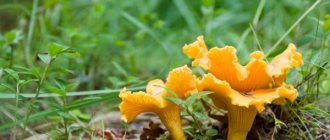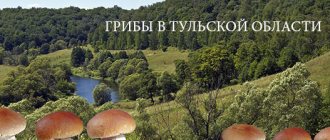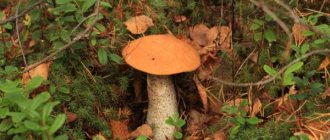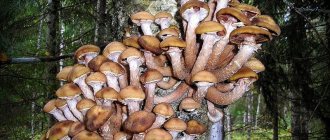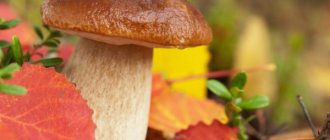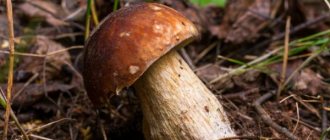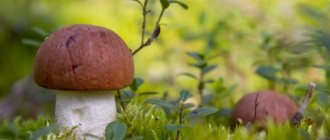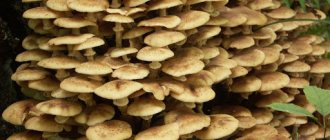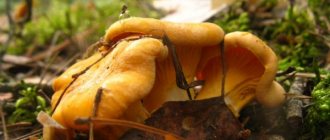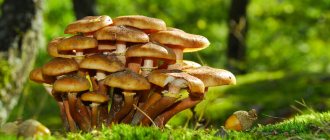0
2889
Article rating
Mushroom picking is a favorite pastime for many people. Mushroom pickers not only take a break from the bustle of the city, but also collect baskets full of forest delicacies. In order for the “silent hunt” to be successful and not cause harm to your health, you need to be able to recognize edible and poisonous mushrooms of the Primorsky Territory.
Characteristics of mushrooms of Primorsky Krai
Edible mushrooms
Primorye is an area where all kinds of mushrooms grow abundantly. From early spring to late autumn, not only in forest groves, but also in city parks and squares, local mushroom pickers collect a bountiful harvest of this delicacy.
The mushroom places of the Primorsky Territory are a real gold mine for lovers of this product. About 750 species grow here (250 are edible and conditionally edible species). Many of them are considered rare and grow well only in coastal climates.
The mushroom kingdom is divided into species that a person fearlessly eats, and those that can harm his health and cause not only poisoning, but also death. Edible mushrooms can be eaten even raw, without subjecting them to heat treatment. They contain many microelements and enrich our body with useful substances.
Inedible ones are dangerous for humans. Despite their attractive appearance, they contain toxic substances. Consumption of such mushrooms often leads to death.
Depending on their taste characteristics, edible mushrooms come in several types.
- Gourmet (ceps, milk mushrooms, saffron milk mushrooms, champignons, oak mushrooms): they have a unique taste and a pronounced aroma that decorates any dish. First and second courses and snacks are prepared from these mushrooms.
- Less elite varieties (row, boletus, boletus): although they have average taste, mushroom pickers love to make homemade preparations from them for the winter. These mushrooms are consumed in canned and dried form.
- Used in cooking for preparing snacks and seasonings (honey mushrooms, moss mushrooms, vodnushki, linden).
- Conditionally edible (oyster mushrooms, spider mushrooms, dung beetles): they are allowed to be eaten only after proper preparation (long soaking in salt and cooking). If you do not follow these procedures before consuming them, you may get food poisoning.
The most famous edible mushrooms that grow in the Primorsky Territory include porcini mushroom, aspen mushroom, row mushrooms, volnushki, and russula.
According to experienced mushroom pickers:
- good harvests of porcini mushrooms usually occur after two years on the third, but unfavorable weather conditions can “knock down” this system.
- The oak, birch and cedar forests located on the southern slopes of the hills can be considered the most mushroom-bearing;
- in more northern regions, the main places for collecting mushrooms are mixed forests, birch forests and cedar trees;
- in the western part of the region, pine forests are considered “respected” mushroom places;
- When there is little rainfall during the mushroom season, mushrooms growing on wood are least affected.
Make and regularly adjust your mushroom map from season to season. It will help you collect large harvests of forest gifts and delight your loved ones in winter with a variety of mushroom delicacies from your own bins.
Porcini
Due to its appearance and unique taste, the royal mushroom is considered a real delicacy. It stands out among its “brothers” with its contrasting colors. Its leg is light, and its cap is a rich brown shade. The diameter of the latter often reaches 15-20 cm. A well-defined mesh is noticeable at the base of the leg.
It is not difficult to determine that you have found exactly the “king of the forest”: it does not change color after being cut and lying in a basket. In Primorye there are the following varieties: oak, pine and pink tubular. Boletus mushrooms grow abundantly in the south of the Primorsky Territory (Yakovlevsky district). The best time for collection is July-August.
Boletus
The second name - redhead (obabok) - is associated with the bright appearance of the mushroom, the cap of which has a brown-red tint. The boletus is distinguished by its large size: the cap reaches 10-30 cm, the leg - 18-22 cm. It is characterized by blue discoloration of the flesh on the cut.
The following varieties of redhead grow in Primorye: oak (brown mushroom), yellow-brown and pine, which can be easily distinguished by the unusual crimson color of the cap.
Since this mushroom grows well on abundantly moist soil, it is a rather rare species for coastal areas. Obabok grows abundantly in aspen forests. Myceliums do not stop bearing fruit until the onset of the first sub-zero temperatures. When collecting forest gifts, lovers of “quiet hunting” should be careful: redhead is easily confused with bitterling.
Rows
Ryadovka is very similar to russula. This mushroom can be either edible (gray, matsutake) or not (white, brown and leopard). It is necessary to pay close attention to the conditions in which the row grows and to its appearance. These mushrooms grow in rows (hence their name), so lovers of “quiet hunting” will not have any difficulty finding them.
A mushroom such as rower grows in the mixed forests of the Primorsky Territory. These are autumn mushrooms that bear fruit abundantly with the arrival of cool days. They begin to collect them at the end of September. If you bring the mushroom to your face and inhale the air, you will smell a specific smell - the smell of burnt flour. This is exactly what the row smells like. They must be cooked before eating.
Russula
Russulas grow abundantly in the Primorsky Territory: in some areas their number amounts to 45-50% of the total forest product. This is a lamellar type of mushroom that grows up to 10-12 cm in height. There are several dozen varieties of russula (the inedible ones are easy to distinguish by their bright colors).
Russulas grow on any soil
Mushroom pickers give the following description of the most popular types of russula:
- greenish - grows in mixed and oak forests;
- yellow – found in birch groves;
- pink – has an unusual purple color.
All of them are eaten and used for preparing winter preserves. Russulas grow well on any soil. They can be found in coniferous, deciduous and mixed forests.
Endemic to Primorye is the edible Russula Vasilyeva. The mushroom got its name in honor of the famous Soviet mycologist L.N. Vasilyeva (1950-2017), who described 100 new species of mushrooms. Vasilyeva's russula is radically different from its counterparts in the clearly visible remains of a private cover: on the surface of the cap in the form of large shreds and in the form of a ring on the stem.
They begin to collect these mushrooms in July. When collecting russula, in order not to confuse the mushroom with a toadstool, you should carefully examine the find.
Volnushki
The description given by mushroom pickers indicates that this is an excellent product for winter pickling. Volnushki can be recognized by their small pink fringed cap. The mushroom is small in size: it does not grow more than 6-8 cm.
Their fruiting period falls in October-November. Volnushki can be found in birch groves, spruce forests and deciduous forests. In Primorye they grow everywhere. The redfish does not have any poisonous counterparts that are contraindicated for consumption. At the end of summer and beginning of autumn, you can collect a large harvest of these mushrooms in birch, spruce or cedar-broadleaf forests.
Application
Primorye mushrooms are most widely used in cooking. They are used to make soups and prepare hot dishes. They are fried, boiled, pickled, salted, dried and frozen.
There are a lot of russula in the forests of Primorye. Russula Kale with a bright purple cap, which has never been heard of in the Moscow region, is good for pickling and housewives are happy to stock it up for the winter.
Honey mushrooms and boletus mushrooms are collected en masse throughout the season.
The Far Eastern obabok is suitable for any use. Its flesh is elastic and dense, pleasant to the taste. The fruiting body reaches large sizes (up to 25 cm in cap diameter). The fungus is found in oak groves in late summer and September.
Greenish and golden russula, which are often found in deciduous forests under oak trees, are suitable for hot pickling, drying and salting.
White milk mushrooms are tasty and not inferior in quality to milk mushrooms.
Pine mushroom is in demand among Asians. They call it "matsutake". Among the local population of Primorye, this forest mushroom is considered poisonous and unsuitable for food. The Chinese cook it skillfully. It is sold in local markets in China for delicacies and medicines. It is believed that when consumed regularly, it removes free radicals and strengthens the immune system.
Poisonous and inedible mushrooms
Every year, inedible and poisonous mushrooms collected in the Primorsky Territory cause numerous food poisonings. Inexperienced mushroom pickers mistake them for edible varieties. To avoid misfortune, it is important to know what poisonous mushrooms look like and their exact name.
More than 20 species of mushrooms growing in Primorye pose a danger to human health (pale toadstool, fly agaric, whitish talker, false honey fungus, shaggy dung beetle, striped dung beetle, etc.). Some of them are so poisonous that it is even forbidden to pick them up, since the toxic substances contained in the spores easily enter the body through the skin.
Death cap
Experienced mushroom pickers give the following description of the white toadstool: a cap, distinguished by a pale yellowish color and reaching 6-9 cm in diameter; a thin leg framed by a ring. Old and dried mushrooms have an unpleasant sweetish smell.
Toadstools grow in mixed forests, especially in the southern part of the region. The mushroom has a high level of danger. Having eaten even a small piece of toadstool, a person receives severe poisoning, which can be fatal. Signs of poisoning may not appear immediately, but after 10-12, or even 30 hours after consumption, when it is almost impossible to save a person.
Fly agaric red
The fly agaric has an original appearance. The orange-red mushroom cap is covered with white spots, and the large cream stem reaches a height of 15 cm.
This poisonous mushroom is found in coniferous, birch and mixed forests of the Primorsky Territory. Its active growth period occurs in mid-summer. Thanks to its memorable appearance, it is difficult to confuse it with other mushrooms. The presence of certain toxins has led to its classification as a so-called “magic” or hallucinogenic mushroom.
Beautiful-legged bolete
These mushrooms have a lot in common with boletus mushrooms due to the large brown-brown cap. Due to the cylindrical stem, the bolet has a squat appearance. It looks very unusual: it is yellowish or beige on top, and red underneath. The hymenophore is tubular, the inner side of the cap (the hymenophore itself) coincides in color with the upper part of the stalk.
The growing conditions for these mushrooms are varied. The beautiful-legged boleta bears fruit from mid-summer until the onset of the first autumn frosts. It is easily confused with edible oak mushrooms and the poisonous satanic mushroom. It belongs to the group of inedible mushrooms due to its characteristic bitter taste, which cannot be removed even by prolonged boiling of the product.
Cinnabar-red redmouth
Belongs to inedible mushrooms from the family False puffballs. It is characterized by a bright red color of the fruiting body, which in young specimens is covered with a thick layer of jelly-like substance.
Found in oak forests in the south of Primorsky Krai. In 2001, as a rare species, the redmouth was listed in the Red Book of the region.
In the early stages, the fruiting body develops underground.
Hedgehogs
There are a lot of Ezhovikov in the Primorsky Territory. In particular, you can find:
- Brown hedgehog.
- Blackberry lobed.
- The hedgehog is imbricated.
They are called hedgehogs because of their characteristic spine-like growths. All of them are edible and respond well to heat treatment.
Brown hedgehog
Blackberry lobed
Blackberry imbricated
Rare species
In the forests of Primorye you can find many rare species of mushrooms
It is easy to find in the forests of Primorye rare specimens that do not grow in other regions of Russia. These varieties include balentius, elmaki, linden, shiitake and udemanciella brown.
Mushroom pickers who come to this region are interested in such representatives of the kingdom as mushroom noodles, tree abalones and black champignons - varieties unique in taste and appearance that can only be found in Primorye. Rare species of mushrooms grow mainly in the south of the region.
But most lovers of “quiet hunting” prefer to collect such delicious varieties as honey mushrooms, boletus mushrooms and boletus mushrooms, which are considered the most delicious.
Tree ears
Residents of the Far East are very familiar with “tree mushrooms”. Mostly they can be found on store shelves, they are packaged in compressed packs. Filling such a briquette with water will make it 15-20 times larger.
These mushrooms have several scientific names - auricularia (hairy or ear-shaped), muer, “tree ears” or “tree jellyfish”.
There are absolutely no calories in abalone, they do not contain vegetable fats, so they can be consumed without restrictions by people who are watching their weight.
Collection time
When planning to pick mushrooms in the Primorsky Territory in 2022, take into account the regional characteristics of the growth of forest delicacies. Ripening in early spring, they continue to bear fruit until the onset of frost. The best time for collection is August and September.
The period of active growth of mushrooms in the region lasts more than six months, and in the south of the region it lasts even longer, up to 8 months. In the north, mushroom picking time is significantly reduced.
The main mushroom places in Primorye are well known to lovers of “silent hunting”. These are cedar and birch groves, coniferous, deciduous and mixed forests. It is important to consider the timing of harvest. Make a mushroom calendar for yourself.
- June: at this time you should look for boletus, boletus and boletus in the forest. They grow in large quantities and do not stop bearing fruit until the end of autumn.
- July: porcini mushroom season. Starting this month, russula, milk mushrooms and chanterelles are collected. These varieties have a pleasant taste. They are widely used in cooking.
- August: the period when mushrooms such as saffron milk caps, boletus, rowers, and tremors appear in the forests of the Primorsky Territory. At this time, mushroom pickers prepare forest products for the winter.
- September: the month when both summer-ripened mushrooms and autumn species are collected.
- October: mushroom pickers may still have time to collect a sufficient amount of product, but with the arrival of the first autumn frosts (with a drop in temperature to 3-6 °C), the mushroom season will be closed.
Remember that in unstable weather the Primorsky region may not please you with a large number of mushrooms. During the dry season, the gifts of the forest should be sought closer to bodies of water, and during the rainy season, on paths and forest edges.
How to prepare forest gifts?
Edible mushrooms can be prepared in different ways, depending on the variety and texture. For example, some mushrooms are ideal for drying and freezing, others are indispensable for winter pickle recipes, and others are suitable for preparing first and second courses.
Red russula, found in the Primorsky Territory, is ideally suited for pickling and canning. They make delicious caviar and snacks.
Even grandmothers used obabki to prepare second courses. Boletuses and boletuses are good with fried potatoes, cabbage stew and even light vegetable salads.
Mushroom pickers most often use honey mushrooms and chanterelles as the main ingredient for making pate.
In 2022, mushrooms from the Primorsky Territory will delight many more mushroom pickers with their unearthly taste and aroma. Free hunting will allow you to save money on delicacies, spending a minimum amount of time preparing any dish.
Rules for "silent hunting"
If you are going on a “quiet hunt”, keep in mind that mushrooms do not grow in overgrown and impassable areas of the forest, in swampy areas and in sunny meadows. You should not look for this product in city parks or squares, near highways, near industrial facilities and railways.
Mushrooms collected in these areas are poisonous. They are full of toxic substances. Eating them can cause damage to human health, cause severe poisoning and even lead to death. Also be careful when purchasing them from street vendors and check that all mushrooms are edible. If you see that the seller only offers you caps, refuse to buy, because it is very difficult to accurately determine that this is an edible mushroom.
When you come to the forest to pick mushrooms, divide the selected area into several sectors. Examine them one by one. Carefully examine the grass around the trees: many varieties of mushrooms like to hide in it. Lift the lower branches of plants lying on the ground.
Explore the forest ditches: boletus, boletus, row and boletus often grow there. A long stick will help you move through the forest.
Don't forget to choose comfortable clothes for your hike in the forest. It should be with long sleeves and preferably plain, so that any bug that gets into it is immediately noticeable. Take a basket or bucket where you will put the harvest. Be sure to stock up on water. When leaving home, warn your family about your trip.
Mokhoviki
Primorye is also rich in moss mushrooms:
- Moss fly yellow-brown.
- Moss fly green.
- Moss fly is red.
- Larch moss.
- Motley moth fly.
- Polish mushroom, chestnut mushroom.
Very tasty mushrooms that belong to the Boletaceae family, like the Boletaceae. They got their name because they prefer to grow in moss.
Moss fly yellow-brown
Green moss
Moss fly red
Larch moss
Motley flywheel
Polish mushroom
Map of mushroom places
When going to the forest, determine in advance the places where you will look for the gifts of the forest. Your mushroom map should include the Yakovlevsky region: most varieties of mushrooms grow in this area, and their growing conditions contribute to abundant fruiting. Some rare species grow near the botanical garden.
Experienced mushroom pickers go to the following areas: Aryag, Shamor, Sadgorod, Sedanka and Patrok. Public transport provides easy access to the northern and southern parts of the region. Visit the villages of Kirovka, Mirny and Tavrichanka.
Belladonna (belladonna)
Until what month are porcini mushrooms collected? where, when and how quickly mushrooms grow
The entire plant is very poisonous. The atropine group alkaloids it contains can cause very severe poisoning. The result can even be death due to paralysis of the respiratory system and cardiac arrest.
Its habitat is beech and hornbeam forests of Central and Eastern Europe, the Mediterranean, Crimea, the Caucasus, Asia Minor, North Africa. In the Krasnodar region it is grown on plantations (for medicinal purposes). Although the plant is very poisonous, most residents of Russia are unlikely to encounter it in natural conditions. Although, of course, you need to know it! Therefore, in my ranking of poisonous berries its place is by no means the highest.
By the way, “belladonna” translated from Italian means “beautiful woman.” And the Russian name is consonant. This is due to the fact that the juice of the plant was dropped into the eyes to dilate the pupils and rubbed on the cheeks to enhance the blush. Beauty truly requires sacrifice!
Precautionary measures
Even an experienced mushroom picker needs to be careful when consuming this product. When going out into the forest for a “silent hunt”, follow a number of rules.
- Don't pick mushrooms you've never heard of before. Advice from friends may be wrong, so choose only proven types.
- Pay attention to the appearance of the mushroom and the area in which it grew. Fruiting bodies, like a sponge, accumulate all harmful substances from the atmosphere and soil. If there is garbage, a road or a polluted river nearby, they will certainly contain harmful substances from this object.
- Examine the cut location. In poisonous varieties, its color changes immediately after you separate them from the mycelium. However, remember that among edible mushrooms there are species that change color. Therefore, seek advice from an experienced mushroom picker.
- Once you get home, start processing the product. Don’t put off this activity “for later.” Sort and peel the mushrooms. Remember that during this you should once again look through the collected gifts of the forest. Do not leave wormy or spoiled specimens.
- Be sure to soak the crop in salted water. This will not only make the product softer, but will also help clean it from invisible pests that live inside many mushrooms. Before eating, the collected mushrooms must be boiled and only after that should they be fried or canned. Only porcini mushrooms are allowed to be eaten raw, but only if you know exactly where they were collected.
- Mushrooms should be eaten with caution. The risk category includes people with chronic diseases of the gastrointestinal tract and kidney failure. This product is difficult to digest. Even absolutely healthy people should not overdo it in their food intake. Do not give mushrooms to small children.
At the first symptoms of poisoning, seek medical help immediately. Take with you those foods that you think are the cause of your poor health.
The Primorsky region is a rich mushroom region. Many edible and rare varieties grow in this area. Be careful not to confuse them with poisonous specimens.
Rows
There are many subspecies of rowers. In the Primorsky Territory, in particular, the following species grow:
- The row is purple.
- The row is gray.
- The row is crowded.
- The row is fused.
These are above-ground mushrooms with caps painted in different colors (less often just white). Young specimens have convex, rounded caps, which become open as the fruiting body ages.
Row purple
Gray row
The row is crowded
The row is fused
First aid for poisoning
The first signs of poisoning from inedible mushrooms include:
- abdominal pain, vomiting, diarrhea;
- excessive secretion of sweat and saliva;
- difficulty breathing;
- weakness, low blood pressure, dizziness;
- weak, barely audible pulse and narrow pupils.
In case of mushroom poisoning and the listed signs appear, the victim should be given first aid and immediately go to the hospital.
Before the ambulance arrives, you need to perform repeated gastric lavage and induce vomiting. After this, dilute burnt magnesium with water and give it to the person who has been poisoned to drink. This remedy will help flush out toxic substances from the small intestine. You can drink activated carbon (10 tablets for an adult).
Poisonous mushrooms can cause irreversible consequences. You should not risk your own health and the health of your family. If you are not sure of the quality of the collected mushrooms, it is better to throw them away so as not to regret what happened later.
